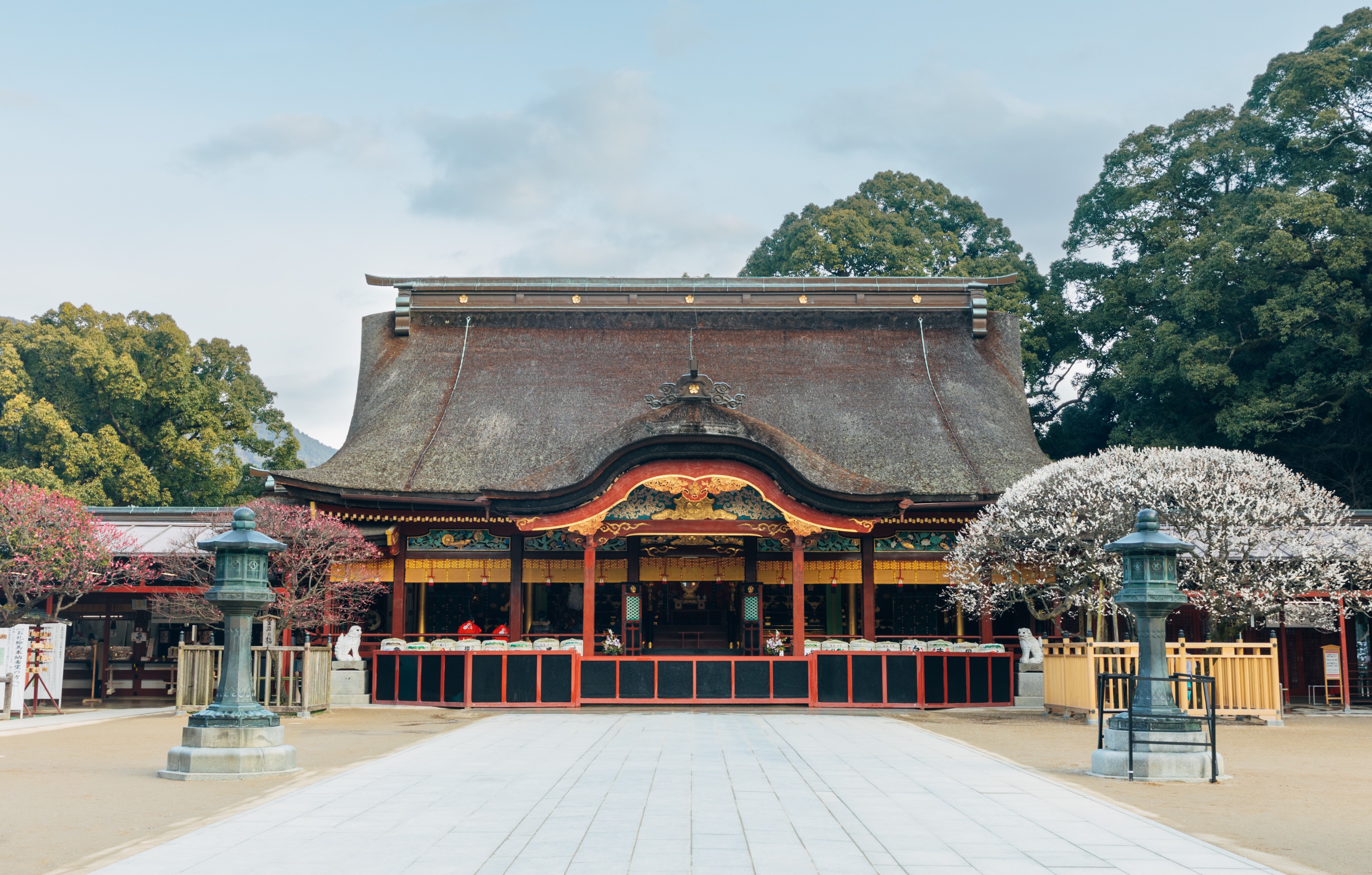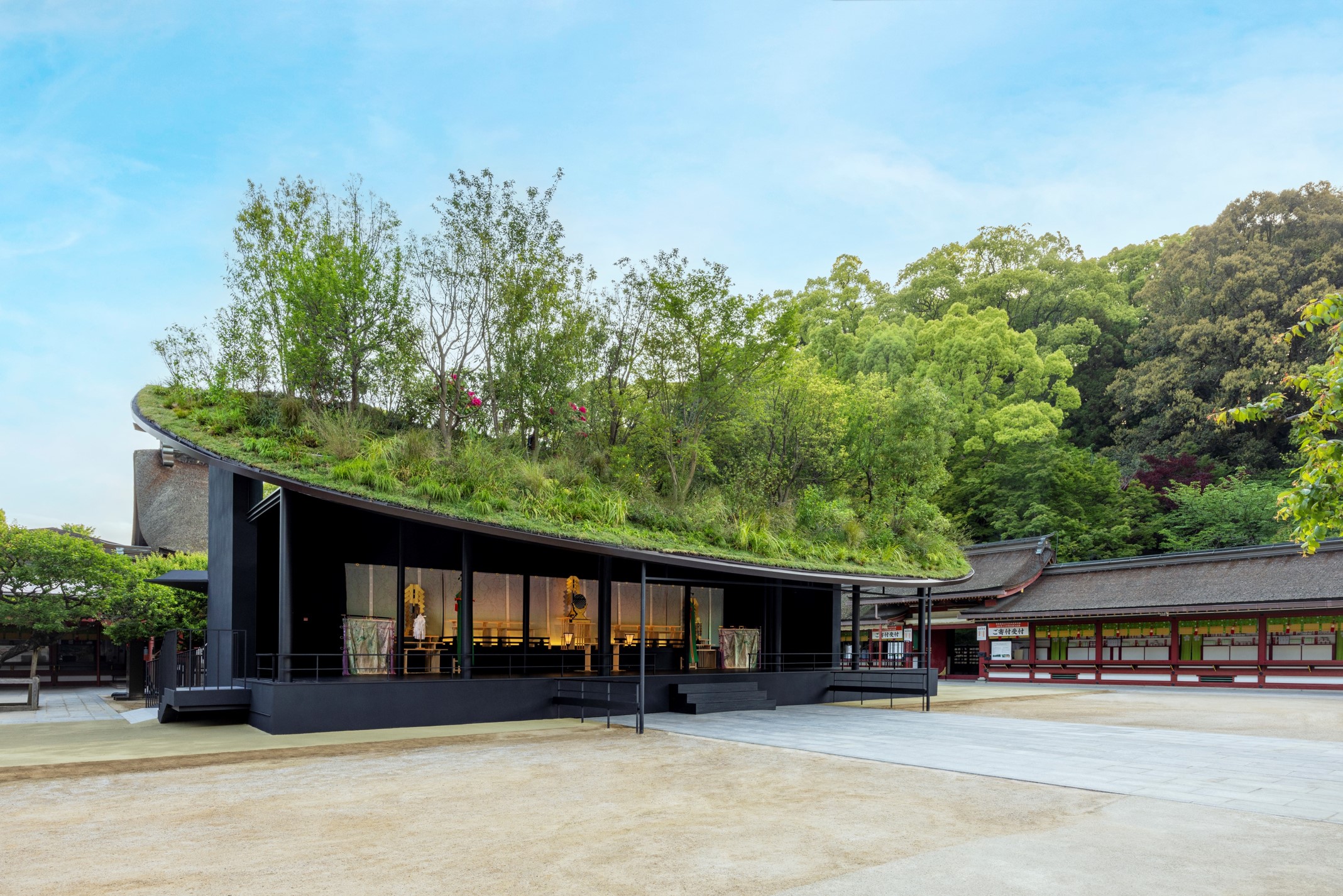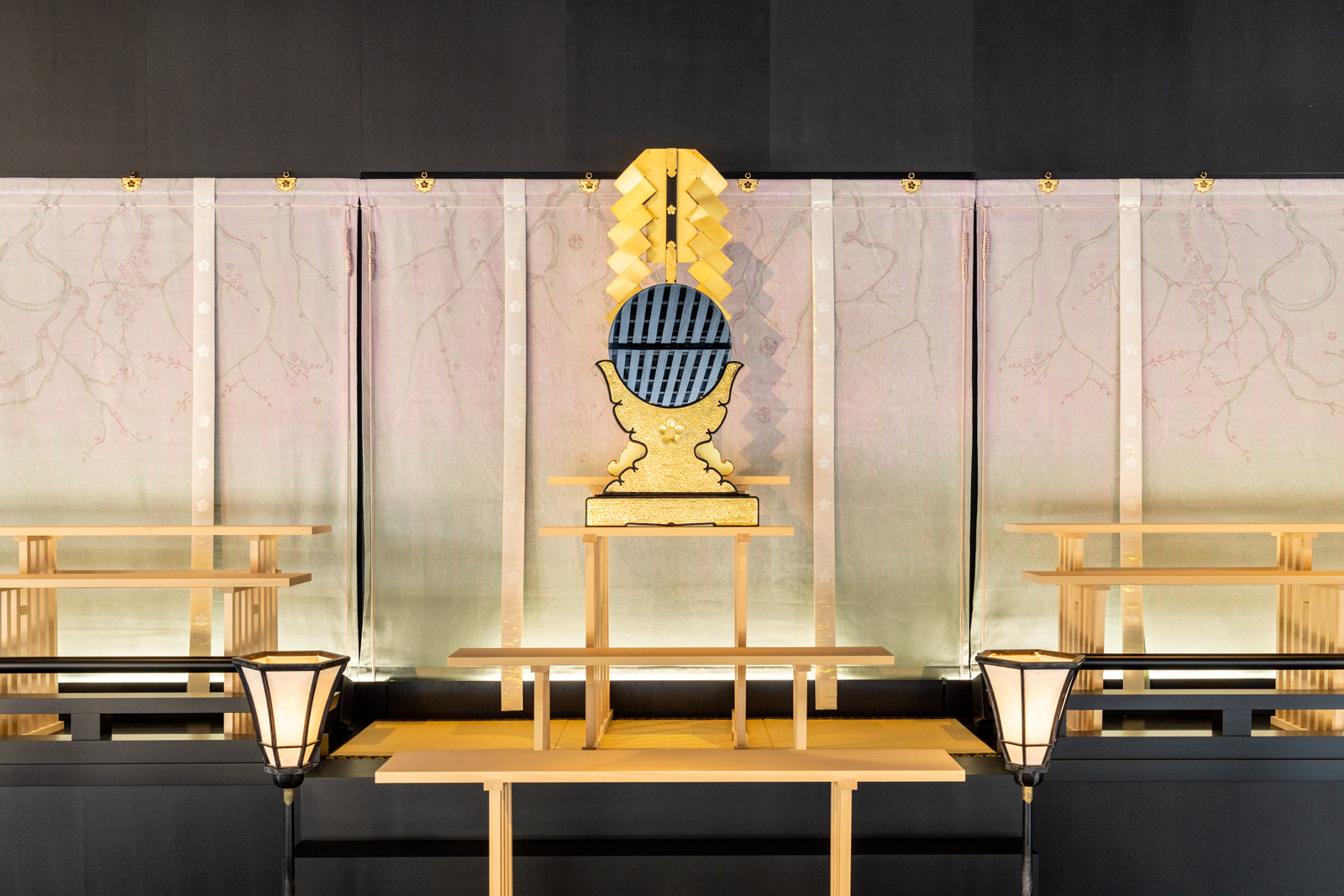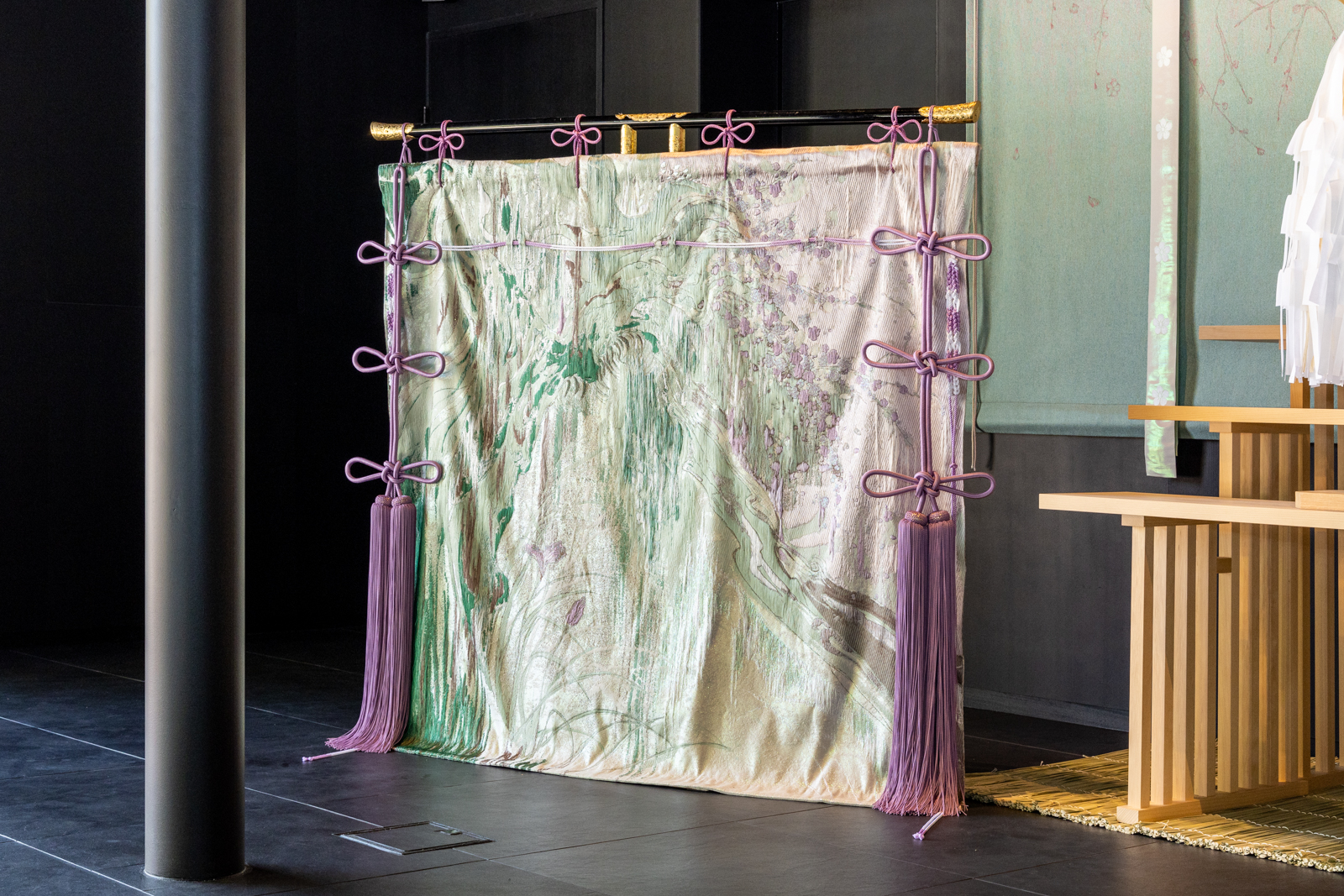
Designed with the spirit of the shrine in mind but new methods, it’s the perfect combination of ancient and modern.
There are many shrines in Japan, but Dazaifu Tenmangu Shrine, located in Dazaifu, just outside of the city of Fukuoka in Kyushu, has a strong claim to being one of the most important. After all, it’s built on the grave of the Heian Era scholar, poet, and politician Sugawara no Michizane, who is now eternally enshrined as Tenjin-sama, the god of learning, culture, and the arts. It also serves as the head of the 12,000 Tenjin shrines all around Japan.
Because of its importance to Tenjin-sama, who was known as a master of Chinese and waka poetry, many artists and poets have visited Dazaifu Tenmangu over the eras and dedicated works to the shrine. Nowadays, it’s a top tourist spot in Kyushu, but if you plan on visiting it in the next three years, know that it’s going to look a little bit different than what you might expect.
▼ Dazaifu Tenmangu’s original main shrine building
Tenjin-sama is closely associated with the number 25, and thus Dazaifu Tenmangu has held a festival every 25 years since Tenjin-sama’s death. 2027 will be a monumental year: the 1,125th anniversary of Tenjin-sama’s death, so the shrine is gearing up for major celebrations. Ahead of that, as of this month, the shrine began renovations on its main shrine building, which is an important cultural property that hasn’t been updated in 124 years.
As a result, the main shrine has been closed, and in front of it, they’ve built a temporary shrine where visitors can still go to pray to Tenjin-sama. But it isn’t just any ramshackle pavilion. In order to connect the spirit of the god’s divine virtues to the present, modern artists were recruited to participate in the design and decoration of the building. Sou Fujimoto, an internationally recognized architect who designed the venue of the Japan World Expo in Osaka, spearheaded the creation of the building with his architecture firm, and the curtains and screens decorating the interior were designed by internationally renowned fashion brand Mame Kurogouchi.
Inspired by the expansive natural beauty in and around Dazaifu Tenmangu, which the shrine takes great pride in, Fujimoto created a temporary shrine with a forest on its roof, lending the building a green, peaceful, beautiful atmosphere. The flora includes plants raised by the shrine’s gardeners, including plum trees, which are a symbol of the shrine. Just like the nature around it, the greenery will grow and change with the shifting of the seasons, revealing a different face for every visit. As for the shape and interior of the building, Fujimoto took influences from the spirit of the original building but gave them a modern twist.
Mame Kurogouchi created fabric designs based on the history of the shrine and of Tenjin-sama, as well as incorporating the essence of the shrine as a whole, using a combination of time-honored dyeing methods and modern looms. The curtains are decorated with plum blossoms, the shrine’s symbol, and have a gorgeous gradient of color and pattern.
The silk used to make the screens was dyed with plum and camphor branches as well as precious gromwell roots using traditional methods, and then woven together with modern synthetic fibers. The threads, which appear to be flowing like water, actually represent a rainstorm the designer, Maiko Kurogouchi, experienced while visiting Dazaifu. According to the designer herself, she was checking out the hole of a giant camphor tree on the grounds when the downpour started, and the feeling of being protected by the tree and the scenery she viewed while inside inspired her to design these screens.
The shrine conducted its Ceremony for Moving a Deity to a New Shrine on May 13, and the temporary building, which will now be the site of worship and rituals for the duration of the renovations, will be open to the public for three years. While it may not be a permanent fixture, it definitely seems worth visiting to see the stunning modern architecture and beautiful screens and curtains.
If you do go, don’t forget to make a pit stop to try Matsugae mochi from nearby Miyajidake Shrine, or, if you’re a Demon Slayer fan, stop by Honmangu Kamado Shrine, also in the neighborhood, to check out its plentiful Demon Slayer fan art!
Source, images: PR Times
Related: Dazaifu Temangu Shrine
● Want to hear about SoraNews24’s latest articles as soon as they’re published? Follow us on Facebook and Twitter!






 Stunning 4K videos of Dazaifu shrine will make you want a nicer screen and a ticket to Fukuoka
Stunning 4K videos of Dazaifu shrine will make you want a nicer screen and a ticket to Fukuoka Five amazing Japanese Starbucks locations that let you keep sightseeing as you take a break
Five amazing Japanese Starbucks locations that let you keep sightseeing as you take a break We try a delicious hidden gem in Fukuoka, unknown to even Japanese people
We try a delicious hidden gem in Fukuoka, unknown to even Japanese people Japanese voodoo dolls with foreign politician photo keep getting nailed to town’s shrine trees
Japanese voodoo dolls with foreign politician photo keep getting nailed to town’s shrine trees Japan’s new difficult-to-drink-from beer glass protects your liver, but it’s a brutal experience
Japan’s new difficult-to-drink-from beer glass protects your liver, but it’s a brutal experience Demon Slayer: Kimetsu no Yaiba gets new roller coaster attractions and food at Universal Studios Japan
Demon Slayer: Kimetsu no Yaiba gets new roller coaster attractions and food at Universal Studios Japan New Pokémon ice cream, dessert drinks, and cool merch coming to Baskin-Robbins Japan【Pics】
New Pokémon ice cream, dessert drinks, and cool merch coming to Baskin-Robbins Japan【Pics】 Hello, cosmetics! Clinique teams up with Hello Kitty this summer for first-time collaboration
Hello, cosmetics! Clinique teams up with Hello Kitty this summer for first-time collaboration New Nintendo Lego kit is a beautiful piece of moving pixel art of Mario and Yoshi【Photos】
New Nintendo Lego kit is a beautiful piece of moving pixel art of Mario and Yoshi【Photos】 Caffeinated ramen for gamers that you can eat with one hand going on sale in Japan
Caffeinated ramen for gamers that you can eat with one hand going on sale in Japan How to order snacks on a Shinkansen bullet train in Japan
How to order snacks on a Shinkansen bullet train in Japan New samurai glasses are Japan’s latest weird must-have souvenir
New samurai glasses are Japan’s latest weird must-have souvenir High-fashion Totoro cuddle purse is like an elegant stroll in the forest【Photos】
High-fashion Totoro cuddle purse is like an elegant stroll in the forest【Photos】 Swords of famous samurai reborn as beautiful kitchen knives from Japan’s number-one katana town
Swords of famous samurai reborn as beautiful kitchen knives from Japan’s number-one katana town Nintendo history you can feel – Super NES, N64, and GameCube controllers become capsule toys
Nintendo history you can feel – Super NES, N64, and GameCube controllers become capsule toys “The most Delicious Cup Noodle in history” – Japan’s French Cup Noodle wins our heart【Taste test】
“The most Delicious Cup Noodle in history” – Japan’s French Cup Noodle wins our heart【Taste test】 Starbucks releases a cute Frappuccino and Unicorn Cake…but not in Japan
Starbucks releases a cute Frappuccino and Unicorn Cake…but not in Japan Kyoto Tower mascot termination reveals dark side behind cute Japanese characters
Kyoto Tower mascot termination reveals dark side behind cute Japanese characters McDonald’s Japan’s Soft Twist Tower: A phantom ice cream only sold at select branches
McDonald’s Japan’s Soft Twist Tower: A phantom ice cream only sold at select branches Yabai Ramen: What makes this Japanese ramen so dangerous?
Yabai Ramen: What makes this Japanese ramen so dangerous? Finally! Nintendo Japan expands Switch 8-bit controller sales to everybody, Online member or not
Finally! Nintendo Japan expands Switch 8-bit controller sales to everybody, Online member or not Japanese government wants to build luxury resorts in all national parks for foreign tourists
Japanese government wants to build luxury resorts in all national parks for foreign tourists To combat declining birth rate, Japan to begin offering “Breeding Visas” to foreigners
To combat declining birth rate, Japan to begin offering “Breeding Visas” to foreigners 10 things you should buy at 7-Eleven in Japan
10 things you should buy at 7-Eleven in Japan Studio Ghibli releases anime heroine cosplay dresses that are super comfy to wear
Studio Ghibli releases anime heroine cosplay dresses that are super comfy to wear Woman charged for driving suitcase without a license in Osaka
Woman charged for driving suitcase without a license in Osaka Studio Ghibli unveils My Neighbour Totoro miniature house model
Studio Ghibli unveils My Neighbour Totoro miniature house model Kyoto experiencing problems with foreign tourists not paying for bus fares, but not on purpose
Kyoto experiencing problems with foreign tourists not paying for bus fares, but not on purpose Fighting mild hunger with a Japanese soda that turns into jelly in the stomach【Taste test】
Fighting mild hunger with a Japanese soda that turns into jelly in the stomach【Taste test】 Studio Ghibli’s Howl’s Moving Castle tapestry unveiled in Japan for first time
Studio Ghibli’s Howl’s Moving Castle tapestry unveiled in Japan for first time McDonald’s new Happy Meals offer up cute and practical Sanrio lifestyle goods
McDonald’s new Happy Meals offer up cute and practical Sanrio lifestyle goods Sales of Japan’s most convenient train ticket/shopping payment cards suspended indefinitely
Sales of Japan’s most convenient train ticket/shopping payment cards suspended indefinitely Sold-out Studio Ghibli desktop humidifiers are back so Totoro can help you through the dry season
Sold-out Studio Ghibli desktop humidifiers are back so Totoro can help you through the dry season Japanese government to make first change to romanization spelling rules since the 1950s
Japanese government to make first change to romanization spelling rules since the 1950s Foreigner’s request for help in Tokyo makes us sad for the state of society
Foreigner’s request for help in Tokyo makes us sad for the state of society Ghibli founders Toshio Suzuki and Hayao Miyazaki contribute to Japanese whisky Totoro label design
Ghibli founders Toshio Suzuki and Hayao Miyazaki contribute to Japanese whisky Totoro label design Doraemon found buried at sea as scene from 1993 anime becomes real life【Photos】
Doraemon found buried at sea as scene from 1993 anime becomes real life【Photos】 Tokyo’s most famous Starbucks is closed
Tokyo’s most famous Starbucks is closed Princesses, fruits, and blacksmiths: Study reveals the 30 most unusual family names in Japan
Princesses, fruits, and blacksmiths: Study reveals the 30 most unusual family names in Japan Tradition meets summer blooms as shrines arrange beautiful floating flower displays【Pics, Video】
Tradition meets summer blooms as shrines arrange beautiful floating flower displays【Pics, Video】 TripAdvisor Japan announces the country’s 10 favorite shrines and temples
TripAdvisor Japan announces the country’s 10 favorite shrines and temples This Year of the Rabbit, visit some of the best Japanese sightseeing spots related to rabbits
This Year of the Rabbit, visit some of the best Japanese sightseeing spots related to rabbits Akihabara’s otaku shrine celebrates PlayStation 5 launch with ethereal one-night event
Akihabara’s otaku shrine celebrates PlayStation 5 launch with ethereal one-night event This “power spot” in Kumamoto, Japan looks straight out of a Ghibli movie, is pure magic 【Photos】
This “power spot” in Kumamoto, Japan looks straight out of a Ghibli movie, is pure magic 【Photos】 Japanese Twitter user posts beautiful photos of what may be Japan’s most picturesque shrine
Japanese Twitter user posts beautiful photos of what may be Japan’s most picturesque shrine Japanese shrine creates special water fountain for thirsty bees
Japanese shrine creates special water fountain for thirsty bees Visiting a maximum security shrine at the foot of the Narita airport runway
Visiting a maximum security shrine at the foot of the Narita airport runway New ‘Shrine Cafe’ in Tokyo offers fortune-telling and counseling services with your tea
New ‘Shrine Cafe’ in Tokyo offers fortune-telling and counseling services with your tea This tiny island you can walk to is a perfect snapshot of why Japan is an amazing place to travel
This tiny island you can walk to is a perfect snapshot of why Japan is an amazing place to travel Huge torii gate found in the middle of a busy Kumamoto intersection
Huge torii gate found in the middle of a busy Kumamoto intersection Feel what it’s like to be a Shinto shrine maiden with shrine’s experience package for foreigners
Feel what it’s like to be a Shinto shrine maiden with shrine’s experience package for foreigners “Cat shrine” status causing problems for Japan’s millennium-old Izumoiwai Shrine
“Cat shrine” status causing problems for Japan’s millennium-old Izumoiwai Shrine Tokyo’s 400-year-old Shinto shrine welcomes Roombas to help with annual susuosame ceremony【Video】
Tokyo’s 400-year-old Shinto shrine welcomes Roombas to help with annual susuosame ceremony【Video】
Leave a Reply